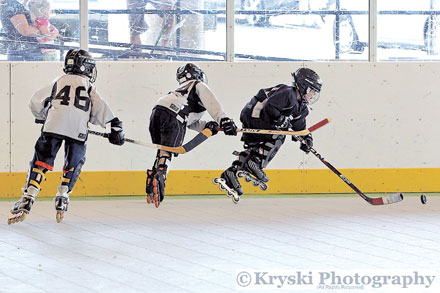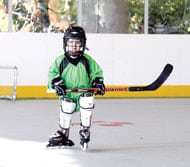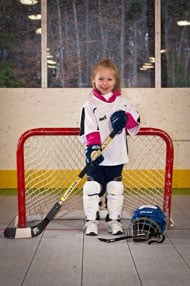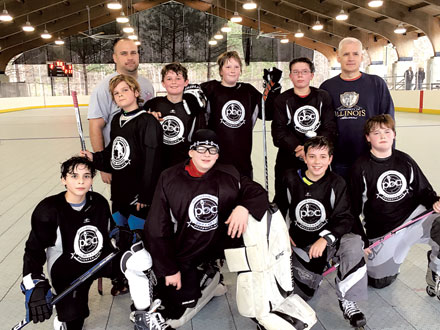
That’s right, tucked in next to the dog park is a skating rink, and there are both youth and adult roller hockey leagues that play there.

The skating facility, located next to the dog park inside Pinckneyville Park, accommodates both street- and roller hockey, as well as plain, old fashioned roller skating. There are bleachers, benches, anything that a hockey fan might see at a pro game (minus the ice, of course). What Thompson and players’ parents would like to see more of, is players. “Right now, there are between 120 and 140 kids, and about 100 adults playing in the leagues,” said Thompson. “That’s not bad, but we’d like to have more, certainly.” There are two seasons in hockey, fall and winter, with fall being the less competitive of the two. Skill development is the focus in the upcoming season, and the spring season can be likened to baseball’s “travel ball,” with more intense, competitive play.

According to Thompson, pediatricians are seeing children’s balance and upper body strength suffering as a result of their lack of what are called “free form” athletics – skating, skateboarding, biking and just “neighborhood” play that parents remember from youth. Video games are of course responsible for some of that loss, but structured team sports are responsible for some of it, too. Children need a balance of all types of play, and for reasons that go beyond physical development. Sometimes, children just need to be able to play, to jump and run, swing and skate, at their own pace. It’s critical to their development.
Laurie Gilmore is a hockey mom, something she had no idea she’d be just a few years ago. “A few years ago, our family got a new dog, and we took him to the dog park at Pinckneyville one day. It happened to be registration day for the upcoming hockey season, so we went to check it out. Our boys were ages 3 and 5 then. Now, they’re 9 and 11, and they’re still playing. They love it!” One of the reasons her boys love the sport so much, especially when they were very young, is that in hockey, the players are constantly moving. “And they have a stick in their hands,” she added, laughing. “It’s perfect for boys!”
“We had tried T-ball, and it was just too slow for them,” said Laurie. Any parent with a very young child just starting out in T-ball can relate; it’s very difficult to hold that child’s attention way out there in right field. Often, picking dandelions and chasing butterflies take precedence to paying attention, at least to the youngest players. In hockey, all players are moving, all the time. To most children, that’s the definition of heaven.
But let’s face it – down here in the Deep South, the sport of hockey is just about as foreign to us as is the ice it’s usually played on. That’s changing though, for several reasons. As mentioned, kids get to move a lot in hockey. For another, parents don’t have to take a second mortgage just for their kids to try it out. In fact, all the necessary equipment for a child to begin play can be rented, with the exception of the stick. Sticks are cut to the exact height of the players using them. And perhaps most important of all, hockey is a very family-friendly sport.
“The league is organized, but it’s also very laid back,” Laurie said. Teams practice one night a week, and they play one game a week. And kids can practice literally any time they want, provided the rink is not being used for play. The Pinckneyville rink is open to the public. Children and adults can use it to practice skills, or simply to skate for the fun of it. At the start of each new season, clinics are available to teach and strengthen skills, but they are not mandatory.
“Of course, the younger you start kids on skates, the better,” Laurie said, but think back to a time when knowing that was just a “given” for parents. Not so long ago, what kid didn’t want his, or her (the league is co-ed) own pair of skates? And at the rink, kids can skate on a surface made of special tiles that are more forgiving than asphalt or a concrete driveway can be on elbows, knees, heads and well, other areas. Those special rinks are called “Sport Courts,” and they’re made specifically for roller hockey.
For more information about area roller hockey, and to view season schedules, visit www.PBCsports.org, then click Norcross Youth Roller Hockey. Registration is open through August, with the fall season starting in September. Email hockey@pbcsports.org, or call Paul Thompson at 404-886-1097 for more information and to ask questions not answered on the website.


